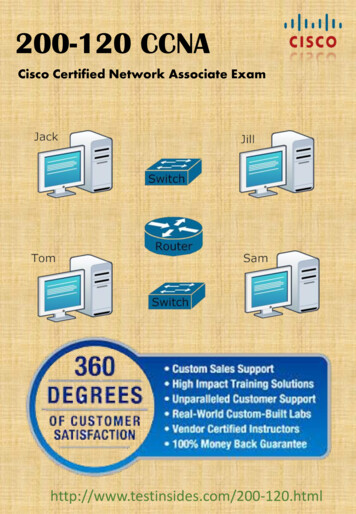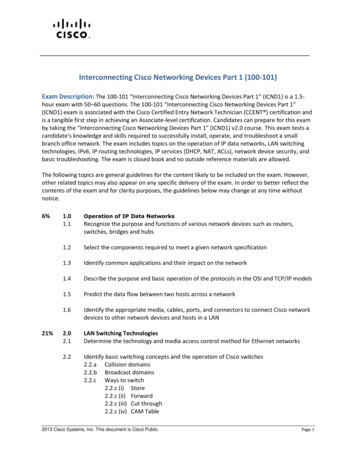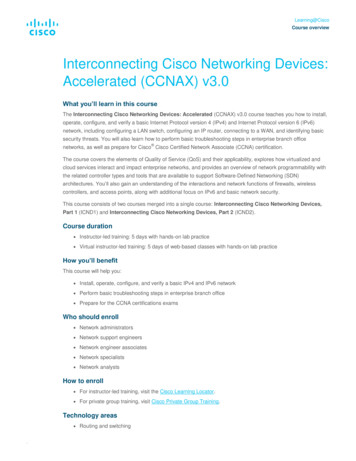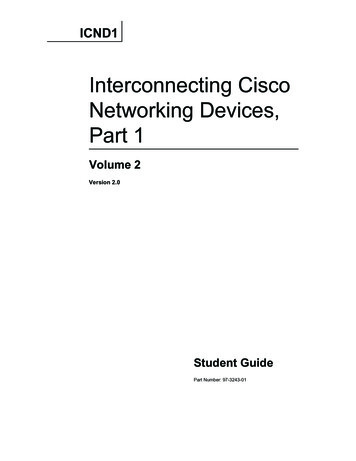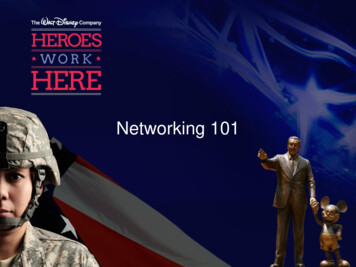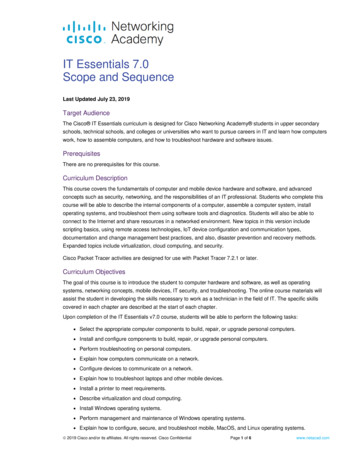
Transcription
CCNAXInterconnecting CiscoNetworking Devices:AcceleratedVersion 2.0Course AdministrationPart Number: To be filled in later
Americas HeadquartersCisco Systems, Inc.San Jose, CAAsia Pacific HeadquartersCisco Systems (USA) Pte. Ltd.SingaporeEurope HeadquartersCisco Systems International BVAmsterdam, The NetherlandsCisco has more than 200 offices worldwide. Addresses, phone numbers, and fax numbers are listed on the Cisco Website atwww.cisco.com/go/offices.Cisco and the Cisco logo are trademarks or registered trademarks of Cisco and/or its affiliates in the U.S. and other countries. Toview a list of Cisco trademarks, go to this URL: www.cisco.com/go/trademarks. Third party trademarks mentioned are the propertyof their respective owners. The use of the word partner does not imply a partnership relationship between Cisco and any othercompany. (1110R)DISCLAIMER WARRANTY: THIS CONTENT IS BEING PROVIDED “AS IS.” CISCO MAKES AND YOU RECEIVE NOWARRANTIES IN CONNECTION WITH THE CONTENT PROVIDED HEREUNDER, EXPRESS, IMPLIED, STATUTORY OR INANY OTHER PROVISION OF THIS CONTENT OR COMMUNICATION BETWEEN CISCO AND YOU. CISCO SPECIFICALLYDISCLAIMS ALL IMPLIED WARRANTIES, INCLUDING WARRANTIES OF MERCHANTABILITY, NON-INFRINGEMENT ANDFITNESS FOR A PARTICULAR PURPOSE, OR ARISING FROM A COURSE OF DEALING, USAGE OR TRADE PRACTICE.This learning product may contain early release content, and while Cisco believes it to be accurate, it falls subject to thedisclaimer above. 2013 Cisco Systems, Inc.
Table of ContentsCourse ManagementC-1Course DescriptionCurriculaCourse Goal and ObjectivesTarget AudiencesPrerequisite Skills and KnowledgeICND1/ICND2 to CCNAX Module MappingCourse Instruction DetailsC-1C-1C-2C-2C-2C-4C-9Instructor Certification RequirementsRequired Classroom Reference MaterialsRequired Classroom EnvironmentDetailed Course FlowC-9C-10C-10C-11Course EvaluationEvaluation LevelsCourse OutlinesHigh Level Course OutlineDetailed Course OutlineCourse IntroductionModule 1: Building a Simple NetworkModule 2: Establishing Internet ConnectivityModule 3: Managing Network Device SecurityModule 4: Introducing IPv6Module 5: Building a Medium-Sized NetworkModule 6: Troubleshooting Basic ConnectivityModule 7: Wide Area NetworksModule 8: Implementing an EIGRP-Based SolutionModule 9: Implementing a Scalable OSPF-Based SolutionModule 10: Network Device ManagementLab SetupGeneral InformationLaboratory Topology (Delivery)Laboratory TopologyLab Topology Diagram (Backbone Pod View)Lab Topology Diagram (Student Pod View)Physical Laboratory EquipmentPhysical Laboratory Software ListPhysical Laboratory Workstation ConfigurationInitial Physical Laboratory BuildGeneral Physical Laboratory SetupLab -47C-48C-48C-49C-51
Lab 1-1: Performing Switch Startup and Initial ConfigurationLab 1-2: Troubleshooting Switch Media IssuesLab 2-1: Performing Initial Router Setup and ConfigurationLab 2-2: Connecting to the InternetLab 3-1: Enhancing the Security of the Initial ConfigurationLab 3-2: Device HardeningLab 3-3: Filtering Traffic with ACLsLab 4-1: Configure and Verify Basic IPv6Lab 4-2: Configure and Verify Stateless AutoconfigurationLab 4-3: Configure and Verify IPv6 RoutingLab 5-1: Configuring Expanded Switched NetworksLab 5-2: Configuring DHCP ServerLab 5-3: Troubleshooting VLANs and TrunksLab 5-4: Optimizing STPLab 5-5: Configuring EtherChannelLab 6-1: Troubleshooting IP ConnectivityLab 7-1: Configuring and Troubleshooting a Serial ConnectionLab 7-2: Establishing a Frame Relay WANLab 7-3: Establishing a GRE TunnelLab 8-1: Implementing EIGRPLab 8-2: Troubleshooting EIGRPLab 8-3: Implementing EIGRP for IPv6Lab 9-1: Implementing OSPFLab 9-2: Configuring Multiarea OSPFLab 9-3: Troubleshooting Multiarea OSPFLab 9-4: Configuring OSPF for IPv6Lab 10-1: SNMP and Syslog Basic ConfigurationLab 10-2: Analyzing NetFlow DataLab 10-3: Managing Cisco Devices and LicensingiiInterconnecting Cisco Networking Devices: -93C-94C-96C-98C-99C-101C-102 2013 Cisco Systems, Inc.
Course ManagementCourse DescriptionThe CCNA curriculum includes a third course, Interconnecting Cisco Networking Devices: Accelerated(CCNAX), a derivative works course consisting of ICND1 and ICND2 content in its entirety, but with thecontent merged into a single course. Overlapping content between ICND1 and ICND2 is eliminated andcontent is rearranged for the purpose of the course flow.This course teaches learners how to install, operate, configure, and verify a basic IPv4 and IPv6 network,including configuring a LAN switch, configuring an IP router, identifying basic security threats,understanding redundant topologies, troubleshooting common network issues, connecting to a WAN,configuring EIGRP and OSPF in both IPv4 and IPv6, understanding wide-area network technologies, andgetting familiar with device management and Cisco licensing. CCNAX v2.0 is augmented by a virtualclassroom presentation, which has additional slides and interactions for instructor use. In addition to theclassic hardware-based lab, Cisco will offer a new set of Cisco Learning Lab Classroom Labs. Learner willencounter more troubleshooting, and more lab time than with the previous version of CCNAX.Full Title of CourseInterconnecting Cisco Networking Devices: AcceleratedCourse AcronymCCNAXCourse Version Number2.0New Course?NoReplaces:Interconnecting Cisco Networking Devices: Accelerated v1.1CurriculaThe course is used in the following curricula, certifications, or specializations:Cisco CCENT Cisco CCNA Routing and Switching Cisco CCDA Cisco CCNA Security Cisco CCNA Voice
Cisco CCNA Wireless Cisco CCNA Service Provider Operations Cisco CCNP Cisco CCDP Course Goal and ObjectivesUpon completing this course, you will be able to meet these objectives:Describe network fundamentals and build simple LANsEstablish Internet connectivityManage network device securityDescribe IPv6 basicsTroubleshoot VLAN issues, explain how STP works, configure EtherChannel, and understand the ideabehind Layer 3 redundancyTroubleshoot IP connectivityDefine the characteristics, functions, and components of a WANConfigure and troubleshoot EIGRP in an IPv4 environment, and configure EIGRP for IPv6Configure, verify, and troubleshoot multi-area OSPFDescribe SNMP, syslog and NetFlow, and manage Cisco device configurations, IOS images, andlicensesTarget AudiencesThis section specifies the primary and secondary target audiences of this course by job roles and notes therelevance to each job role.Target Candidate: Individuals seeking the Cisco CCNA Routing and Switching certification. The courseis also appropriate for pre-sales and post-sales network engineers involved in the installation and support ofenterprise branch office networks.Key Job Tasks:Configure: Implement the identified solution by applying the planned implementation processes usingCisco IOS commands and applications in the correct order to the selected devices and portions of thenetwork.Verify: Use the appropriate show and debug commands and applications to ensure that the solutionwas correctly implemented and is performing as desired.Troubleshoot: Use the appropriate show and debug commands and applications to identify the causeof basic level network issues and correctly implement a solution that ensures the network is performingas desired.Job roles: Entry Level Network Engineer, Network Administrator, Network Support Technician orHelp Desk Technician.Prerequisite Skills and KnowledgeThe knowledge and skills that a learner must have before attending this course are as follows:Basic computer literacyC-2Interconnecting Cisco Networking Devices: Accelerated 2013 Cisco Systems, Inc.
Basic PC operating system navigation skillsBasic Internet usage skillsBasic IP address knowledge 2013 Cisco Systems, Inc.Course AdministrationC-3
ICND1/ICND2 to CCNAX Module MappingCCNAX v2.0 is a course that merges the ICND1 v2.0 and ICND2 v2.0 courses. The first three modules ofCCNAX (Building a Simple Network, Establishing Internet Connectivity, Managing Network DeviceSecurity) are mapped from ICND1 without modifications. The fourth module of CCNAX is IntroducingIPv6, taken from ICND1 and adapted by removing OSPFv3 discussion and configuration. The fifth modulein CCNAX is called Building a Medium-Sized Network and merges the ICND1 module of the same nameand the ICND2 module Implementing Scalable Medium-Sized Switched Networks. Troubleshooting BasicConnectivity, the sixth module, is copied from ICND2. The next three modules, Wide-Area Networks,Implementing an EIGRP-Based Solution and Implementing a Scalable OSPF-Based Solution, take modulesof the same name from ICND2 and merge them with few basic concepts that were introduced in ICND1.The last module, Network Device Management, is taken from ICND2. ICND1 Superlab, ICND2 ReviewLab, and ICND2 Superlab are not included in CCNAX v2.0.ICND1 v2.0CCNAX v2.0M1Building a Simple NetworkM1Building a Simple NetworkM1L1Exploring the Functions of NetworkingM1L1Exploring the Functions of NetworkingM1L2Understanding the Host-to-Host CommunicationsModelM1L2Understanding the Host-to-HostCommunications ModelM1L3Introducing LANsM1L3Introducing LANsM1L4Operating Cisco IOS SoftwareM1L4Operating Cisco IOS SoftwareM1L5Starting a SwitchM1L5Starting a SwitchM1L6LAB Performing Switch Startup and InitialConfigurationM1L6LAB Performing Switch Startup and InitialConfigurationM1L7Understanding Ethernet and Switch OperationM1L7Understanding Ethernet and SwitchOperationM1L8Troubleshooting Common Switch Media IssuesM1L8Troubleshooting Common Switch MediaIssuesM1L9LAB Troubleshooting Switch Media IssuesM1L9LAB Troubleshooting Switch Media IssuesM2Establishing Internet ConnectivityM2Establishing Internet ConnectivityM2L1Understanding the TCP/IP Internet LayerM2L1Understanding the TCP/IP Internet LayerM2L2IP Addressing and SubnetsM2L2IP Addressing and SubnetsM2L3Understanding the TCP/IP Transport LayerM2L3Understanding the TCP/IP Transport LayerM2L4Exploring the Functions of RoutingM2L4Exploring the Functions of RoutingC-4Interconnecting Cisco Networking Devices: Accelerated 2013 Cisco Systems, Inc.
ICND1 v2.0CCNAX v2.0M2L5Configuring a Cisco RouterM2L5Configuring a Cisco RouterM2L6LAB Performing Initial Router Setup andConfigurationM2L6LAB Performing Initial Router Setup andConfigurationM2L7Exploring the Packet-Delivery ProcessM2L7Exploring the Packet-Delivery ProcessM2L8Enabling Static RoutingM2L8Enabling Static RoutingM2L9Managing Traffic Using ACLsM2L9Managing Traffic Using ACLsM2L10Enabling Internet ConnectivityM2L10Enabling Internet ConnectivityM2L11LAB Connecting to the InternetM2L11LAB Connecting to the InternetM3Managing Network Device SecurityM3Managing Network Device SecurityM3L1Securing Administrative AccessM3L1Securing Administrative AccessM3L2LAB Enhancing the Security of the InitialConfigurationM3L2LAB Enhancing the Security of the InitialConfigurationM3L3Implementing Device HardeningM3L3Implementing Device HardeningM3L4LAB Device HardeningM3L4LAB Device HardeningM3L5Implementing Traffic Filtering with ACLsM3L5Implementing Traffic Filtering with ACLsM3L6LAB Filtering Traffic with ACLsM3L6LAB Filtering Traffic with ACLsM4Building a Medium-Sized NetworkM4L1Implementing VLANs and TrunksM4L2Routing between VLANsM4L3LAB Configuring Expanded Switched NetworksM4L4Using a Cisco Network Devices as a DHCPServerM4L5LAB Configuring DHCP Server 2013 Cisco Systems, Inc.Course AdministrationC-5
ICND1 v2.0CCNAX v2.0M4L6Introducing WAN TechnologiesMerged into Understanding WANTechnologiesM4L7Introducing Dynamic Routing ProtocolsMerged into Understanding EIGRPM4L8Implementing OSPFM4L9LAB Implementing OSPFM5Introducing IPv6M4Introducing IPv6M5L1Introducing Basic IPv6M4L1Introducing Basic IPv6M5L2LAB Configure and Verify Basic IPv6M4L2LAB Configure and Verify Basic IPv6M5L3Understanding IPv6M4L3Understanding IPv6M5L4LAB Configure and Verify StatelessAutoconfigurationM4L4LAB Configure and Verify StatelessAutoconfigurationM5L5Configuring IPv6 RoutingM4L5Configuring IPv6 Routing (adapted)M5L6LAB Configure and Verify IPv6 RoutingM4L6LAB Configure and Verify IPv6 Routing(adapted)M5Building a Medium-Sized NetworkM5L1Implementing VLANs and TrunksM5L2Routing Between VLANsM5L3LAB Configuring Expanded SwitchedNetworksM5L4Using a Cisco Network Devices as a DHCPServerM5L5LAB Configuring DHCP ServerM6ICND1 SuperlabRemovedICND2 v2.0M1Review of ICND1M2Implementing Scalable Medium-Sized SwitchedNetworksC-6Interconnecting Cisco Networking Devices: AcceleratedRemoved 2013 Cisco Systems, Inc.
ICND1 v2.0CCNAX v2.0M2L1Troubleshooting VLAN ConnectivityM5L6Troubleshooting VLAN ConnectivityM2L2LAB Troubleshoot VLANs and TrunksM5L7LAB Troubleshoot VLANs and TrunksM2L3Building Redundant Switched TopologiesM5L8Building Redundant Switched TopologiesM2L4LAB Optimizing STPM5L9LAB Optimizing STPM2L5Improving Redundant Switched Topologies withEtherchannelM5L10Improving Redundant Switched Topologieswith EtherchannelM2L6LAB Configuring EtherChannelM5L11LAB Configuring EtherChannelM2L7Understanding Layer 3 RedundancyM5L12Understanding Layer 3 RedundancyM3Troubleshooting Basic ConnectivityM6Troubleshooting Basic ConnectivityM3L1Troubleshooting Basic ConnectivityM6L1Troubleshooting Basic ConnectivityM3L2LAB Troubleshooting IP ConnectivityM6L2LAB Troubleshooting IP ConnectivityM3L3Troubleshooting IPv6 Network ConnectivityM6L3Troubleshooting IPv6 Network ConnectivityM7Wide-Area NetworksM7L1Understanding WAN Technologies (merged)M7L2Configuring and Troubleshooting a SerialEncapsulationM7L3LAB Configuring a Serial ConnectionM7L4Establishing a WAN Connection using FrameRelayM7L5LAB Establishing a Frame Relay WANM7L6Introducing VPN SolutionsM7L7Configuring GRE TunnelsM7L8LAB Establishing a GRE Tunnel 2013 Cisco Systems, Inc.Course AdministrationC-7
ICND1 v2.0CCNAX v2.0M4Implementing an EIGRP-Based SolutionM8Implementing an EIGRP-Based SolutionM4L1Implementing EIGRPM8L1Implementing EIGRP (merged)M4L2LAB Implementing EIGRPM8L2LAB Implementing EIGRPM4L3Troubleshooting EIGRPM8L3Troubleshooting EIGRPM4L4LAB Troubleshooting EIGRPM8L4LAB Troubleshooting EIGRPM4L5Implementing EIGRP for IPv6M8L5Implementing EIGRP for IPv6M4L6LAB Implementing EIGRP for IPv6M8L6LAB Implementing EIGRP for IPv6M5Implementing a Scalable Multiarea NetworkOSPF-Based SolutionM9Implementing a Scalable OSPF-BasedSolutionM9L1Implementing OSPF (merged)M9L2LAB Implementing OSPFM5L1OSPF OverviewM5L2Multiarea OSPF IPv4 ImplementationM9L3Multiarea OSPF IPv4 ImplementationM5L3LAB Configuring Multiarea OSPFM9L4LAB Configuring Multiarea OSPFM5L4Troubleshooting Multiarea OSPFM9L5Troubleshooting Multiarea OSPFM5L5LAB Troubleshooting Multiarea OSPFM9L6LAB Troubleshooting Multiarea OSPFM5L6Examining OSPFv3M9L7Examining OSPFv3M5L7LAB Configuring OSPF for IPv6M9L8LAB Configuring OSPF for IPv6M6Wide-Area NetworksM6L1Understanding WAN TechnologiesM6L2Configuring Serial EncapsulationC-8Interconnecting Cisco Networking Devices: AcceleratedMerged into Implementing OSPF 2013 Cisco Systems, Inc.
ICND1 v2.0CCNAX v2.0M6L3LAB Configuring and Troubleshooting a SerialConnectionM6L4Establishing a WAN Connection using FrameRelayM6L5LAB Establishing a Frame Relay WANM6L6Introducing VPN SolutionsM6L7Configuring GRE TunnelsM6L8LAB Establishing a GRE TunnelM7Network Device ManagementM10Network Device ManagementM7L1Configuring Network Devices to Support NetworkManagement ProtocolsM10L1Configuring Network Devices to SupportNetwork Management ProtocolsM7L2LAB SNMP and Syslog Basic ConfigurationM10L2LAB SNMP and Syslog Basic ConfigurationM7L3Paper Lab: Analyzing NetFlow DataM10L3Paper Lab: Analyzing NetFlow DataM7L4Managing Cisco DevicesM10L4Managing Cisco DevicesM7L5LicensingM10L5LicensingM7L6LAB Managing Cisco Devices and LicensingM10L6LAB Managing Cisco Devices and LicensingM8ICND2 SuperlabRemovedDifferent colors indicate how content was merged and repositioned into CCNAX course.Course Instruction DetailsInstructor Certification RequirementsTo teach this course, instructors must have attended the following training or completed the followingrequirements:New Instructor: 2013 Cisco Systems, Inc.Course AdministrationC-9
Certified Cisco Systems Instructor (CCSI) in good standingCisco CCNA R&S certifiedComplete one of the following:Attend the CCNAX v2.0 courseAttend the ICND1 v2.0 and ICND2 v2.0 coursesCurrent CCNAX Instructor:Certified Cisco Systems Instructor (CCSI) in good standingCisco CCNA R&S certifiedComplete one of the following:Attend CCNAX v2.0 courseAttend ICND1 v2.0 and ICND2 v2.0 coursesAttend ICND1 v2.0 and ICND2 v2.0 train-the-trainer (TTT)Attend ICND1 v2.0 and ICND2 v2.0 On-demand train-the-trainer (TTT)Required Classroom Reference MaterialsRequired ItemExplanation and NotesStudent GuideAvailable in hard copy or electronic version.Lab GuideAvailable in hard copy or electronic version.Course Evaluation FormEach learner should be encouraged to complete astandard online survey, with results reported in MetricsThat Matter.Course Administration GuideYour reference for course delivery.Instructor Slide PackageContains materials for course delivery.OtherRequired Classroom EnvironmentThis information describes recommended class size and classroom setup:Room large enough for 16 learners, set up classroom-style with chairs and tablesA projector capable of displaying slidesProjection screen, as neededWhiteboard with surface area of 4 x 8 feet or greaterUsable dry-erase pens in multiple colorsClimate controlSufficient power for all equipmentFor local labs, rack and floor space to locate all equipmentFor remote lab delivery, access to the Internet for all learners and the instructorC-10 Interconnecting Cisco Networking Devices: Accelerated 2013 Cisco Systems, Inc.
Detailed Course FlowAn accelerated course typically delivers a given amount of content over a shorter period than normal. Asopposed to a traditional five-day course flow schedule, the following table outlines approximately how longeach module will take to deliver. The timing of each module does include the time that it will take tocomplete the corresponding labs, but does not include lunch or breaks. You may make adjustments basedon the skills, knowledge, and preferences of the learners in attendance. The presentation of all topics isoptional for noncertification offerings, but you are encouraged to use them because they are designed toreinforce the lesson concepts and ensure that learners apply some of the concepts.CCNAX ModuleTimingModule 0: Course Introduction0:30Module 1: Building a Simple Network6:00Module 2: Establishing Internet Connectivity7:30Module 3: Managing Network Device Security5:30Module 4: Introducing IPv63:00Module 5: Building a Medium-Sized Network9:30Module 6: Troubleshooting Basic Connectivity2:00Module 7: Wide-Area Networks6:30Module 8: Implementing an EIGRP-Based Solution4:00Module 9: Implementing a Scalable OSPF-BasedSolution5:00Module 10: Network Device Management3:30Total53:00 2013 Cisco Systems, Inc.Course AdministrationC-11
C-12 Interconnecting Cisco Networking Devices: Accelerated 2013 Cisco Systems, Inc.
Course EvaluationEvaluation LevelsThe effectiveness of the course will be evaluated at these levels of the Kirkpatrick performance evaluation:Level 1: Reaction to the courseCourse effects: End-of-module (or end-of-lesson) quizzes, lab solution assessments, and casestudy assessments will be administered by the instructor, and may include group discussions andindividual queries.Course evaluation: Each learner will be encouraged to complete a standard online survey, withresults reported in Metrics That Matter.Level 2: Learning retainedCourse effects: Certification exam pass rates and reliability studies will compare to the JTA jobtasks.Course evaluation: Certification exam pass rates and reliability studies will compare to the JTAjob tasks.Level 3: Performance changes after the curriculumCurriculum effects: Curriculum evaluation will be performed, including surveys and focusgroups of students, instructors, and SMEs.Curriculum evaluation: Curriculum evaluation will be performed, including surveys and focusgroups of students, instructors, and SMEs.Level 4: Results on the job, after the curriculumCurriculum effects: Voluntary, opt-in survey responses will be conducted and compared to theJTA and Claims and Component Skills.Curriculum evaluation: Voluntary, opt-in survey responses will be conducted and compared tothe JTA and Claims and Component Skills.
C-14 Interconnecting Cisco Networking Devices: Accelerated 2013 Cisco Systems, Inc.
Course OutlinesHigh Level Course OutlineThis subtopic provides an overview of how the course is organized. The course contains these components:Building a Simple NetworkEstablishing Internet ConnectivityManaging Network Device SecurityIntroducing IPv6Building a Medium-Sized NetworkTroubleshooting Basic ConnectivityWide Area NetworksImplementing an EIGRP-Based SolutionImplementing a Scalable OSPF-Based SolutionNetwork Device ManagementLab 1-1: Performing Switch Startup and Initial ConfigurationLab 1-2: Troubleshooting Switch Media IssuesLab 2-1: Performing Initial Router Setup and ConfigurationLab 2-2: Connecting to the InternetLab 3-1: Enhancing the Security of the Initial ConfigurationLab 3-2: Device HardeningLab 3-3: Filtering Traffic with ACLsLab 4-1: Configure and Verify Basic IPv6Lab 4-2: Configure and Verify Stateless AutoconfigurationLab 4-3: Configure and Verify IPv6 RoutingLab 5-1: Configuring Expanded Switched NetworksLab 5-2: Configuring DHCP Server
Lab 5-3: Troubleshooting VLANs and TrunksLab 5-4: Optimizing STPLab 5-5: Configuring EtherChannelLab 6-1: Troubleshooting IP ConnectivityLab 7-1: Configuring and Troubleshooting a Serial ConnectionLab 7-2: Establishing a Frame Relay WANLab 7-3: Establishing a GRE TunnelLab 8-1: Implementing EIGRPLab 8-2: Troubleshooting EIGRPLab 8-3: Implementing EIGRP for IPv6Lab 9-1: Implementing OSPFLab 9-2: Configuring Multiarea OSPFLab 9-3: Troubleshooting Multiarea OSPFLab 9-4: Configuring OSPF for IPv6Lab 10-1: SNMP and Syslog Basic ConfigurationLab 10-2: Analyzing NetFlow DataLab 10-3: Managing Cisco Devices and LicensingDetailed Course OutlineThis in-depth outline of the course structure lists each module, lesson, and topic.Course IntroductionThe Course Introduction provides learners with the course objectives and prerequisite learner skills andknowledge. The Course Introduction presents the course flow diagram and the icons that are used in thecourse illustrations and figures. This course component also describes thecurriculum for this course, providing learners with the information that they need to make decisionsregarding their specific learning path.OverviewCourse Goal and ObjectivesCourse FlowAdditional ReferencesYour Training CurriculumModule 1: Building a Simple NetworkModule Objective: Describe network fundamentals and build simple LANsLesson 1: Exploring the Functions of NetworkingLesson Objective: Identify the components of a computer network and describe their basic characteristicsThis lesson includes these topics:What Is a Network?C-16 Interconnecting Cisco Networking Devices: Accelerated 2013 Cisco Systems, Inc.
VC Challenge Question: Physical Components of a NetworkPhysical Components of a NetworkVC Poll Question: Primary Function of a RouterInterpreting a Network DiagramImpact of User Applications on the NetworkCharacteristics of a NetworkPhysical vs. Logical TopologiesVC Interactivity: Logical TopologiesVC Interactivity: Common Network TopologiesSummaryLesson 2: Understanding the Host-to-Host Communications ModelLesson Objective: Understand the model of host-to-host communicationThis lesson includes these topics:Introducing Host-to-Host CommunicationsOSI Reference ModelVC Challenge Question: Layered ModelsTCP/IP Protocol SuiteVC Poll Question: Internet LayerEncapsulation and De-EncapsulationPeer-to-Peer CommunicationsVC Interactivity: Layer IdentificationVC Discussion Question: Benefits of Using a Layered ModelSummaryLesson 3: Introducing LANsLesson Objective: Describe LANs and the role of switches within LANsThis lesson includes these topics:Local Area NetworksVC Challenge Question: LANs vs. WANsLAN ComponentsVC Interactivity: LAN DevicesNeed for SwitchesSwitchesSummaryLesson 4: Operating Cisco IOS SoftwareLesson Objective: Describe the features and functions of the Cisco IOS Software 2013 Cisco Systems, Inc.Course AdministrationC-17
This lesson includes these topics:Cisco IOS Software Features and FunctionsCisco IOS CLI FunctionsUser EXEC ModePrivileged EXEC ModeVC Interactivity: EXEC Mode PromptHelp Functions in the CLICLI Error MessagesManaging Cisco IOS ConfigurationsVC Poll Question: Making Configuration BackupsImproving the User Experience in the CLIVC Interactivity: Hot Keys and ShortcutsSummaryLesson 5: Starting a SwitchLesson Objective: Install a switch and perform the initial configurationThis lesson includes these topics:Switch InstallationVC Challenge Question: Switch BootingSwitch LED IndicatorsConnecting to a Console PortBasic Switch ConfigurationInstructor Note: Do not spend too much time explaining all the details regarding VLAN interface, IPaddress assignment, etc. Focus here is just overview of basic configuration commands.VC Interactivity: Port ConfigurationVerifying the Switch Initial Startup StatusVC Poll Question: Switch UptimeVC Discussion Question: Incorrect IP AddressSummaryLab 1-1: Performing Switch Startup and Initial ConfigurationLab Objective: Restart the switch and verify the initial configuration messagesThis lab includes these tasks:Task 1: Perform a Reload and Verify that the Switch Is UnconfiguredTask 2: Configure the Switch with a Hostname and an IP AddressTask 3: Explore Context-Sensitive HelpTask 4: Improve the Usability of the CLIC-18 Interconnecting Cisco Networking Devices: Accelerated 2013 Cisco Systems, Inc.
Lesson 6: Understanding Ethernet and Switch OperationLesson Objective: Describe Ethernet as the network access layer of TCP/IP and describe the operation ofswitchesThis lesson includes these topics:Ethernet LAN Connection MediaEthernet Frame StructureMAC AddressesVC Interactivity: Vendor-Assigned Part of the MAC AddressSwitching OperationVC Interactivity: Unicast Frame ProcessingVC Interactivity: Switching ProcessVC Interactivity: ForwardingDuplex CommunicationConfiguring Duplex and Speed OptionsVC Interactivity: Full Duplex vs. Half DuplexSummaryLesson 7: Troubleshooting Common Switch Media IssuesLesson Objective: Identify and resolve common switched network issuesThis lesson includes these topics:Common Troubleshooting ToolsMedia IssuesTroubleshooting Switch Media IssuesVC Poll Question: The show interface CommandVC Interactivity: Troubleshooting Media IssuesPort IssuesTroubleshooting Port IssuesVC Interactivity: Troubleshooting Speed and Duplex IssuesSummaryLab 1-2: Troubleshooting Switch Media IssuesLab Objective: Follow troubleshooting guidelines to determine the source of connectivity problemsbetween a computer and a switch, and fix themThis lab includes these tasks:Task 1: Lab SetupTask 2: Troubleshoot Connectivity Between Computer PC1 and Switch SW1Task 3: Troubleshoot Connectivity Between Switch SW1 and the Branch Router 2013 Cisco Systems, Inc.Course AdministrationC-19
Lesson 8: Module SummaryLesson Objective:This lesson includes these topics:ReferencesLesson 9: Module Self-CheckLesson Objective:This lesson includes these topics:Module 2: Establishing Internet ConnectivityModule Objective: Establish Internet connectivityLesson 1: Understanding the TCP/IP Internet LayerLesson Objective: Describe IPv4 and its addressing schemeThis lesson includes these topics:Internet ProtocolIPv4 Address RepresentationIPv4 Header Address FieldsInstructor Note: The IPv4 header has many fields, but at this point, students only need to know aboutthe destination and source address. The whole header is displayed only so that students are made awarethat it comprises more than those two fields.Decimal and Binary SystemsDecimal-to-Binary ConversionInstructor Note: Focus of topic is to illustrate how conversion can be done. Students may usecalculators to convert between decimal and binary numbers when performing calculations on their own.IP Address ClassesReserved IPv4 AddressesVC Interactivity: Reserved IPv4 AddressDomain Name SystemVerifying the IPv4 Address of a HostVC Interactivity: The ipconfig commandSummaryLesson 2: Understanding IP Addressing and SubnetsLesson Objective: Describe subnets, subnetting, and the role of subnet masksThis lesson includes these topics:VC Challenge Question: SubnetworkingSubnetsSubnet MasksC-20 Interconnecting Cisco Networking Devices: Accelerated 2013 Cisco Systems, Inc.
Octet Values of a Subnet MaskVC Discussion Question: Number of SubnetsDefault GatewaysComputing Usable Subnetworks and HostsApplying Subnet MasksDetermining the Network Addressing SchemeVC Interactivity: Host AddressExample: Addressing SchemeInstructor Note: Network engineers rarely do subnetting by hand now. Students should understand howsubnetting works so they will be able to use a usable IP address if they are given a subnet. You can alsoshow them one of the many online subnet calculators.Variable-Length Subnet MaskVLSM ExampleVC Interactivity: Number of Bits BorrowedVC Interactivity: Subnet MaskVC Interactivity: Broadcast AddressSummaryLesson 3: Understanding the TCP/IP Transport LayerLesson Objective: Describe the TCP/IP transport layerThis lesson includes these topics:TCP/IP Transport Layer FunctionsReliable vs. Best-Effort TransportTCP vs. UDP AnalogyUDP CharacteristicsTCP CharacteristicsVC Interactivity: Reliable vs. Best-Effort ComparisonTCP/IP ApplicationsVC Interactivity: Port NumbersSummaryLesson 4:
ICND1/ICND2 to CCNAX Module Mapping CCNAX v2.0 is a course that merges the ICND1 v2.0 and ICND2 v2.0 courses. The first three modules of CCNAX (Building a Simple Network, Establishing Internet Connectivity, Managing Network Device Security) are mapped from ICND1 without modifications. The fourth module of CCNAX is Introducing

